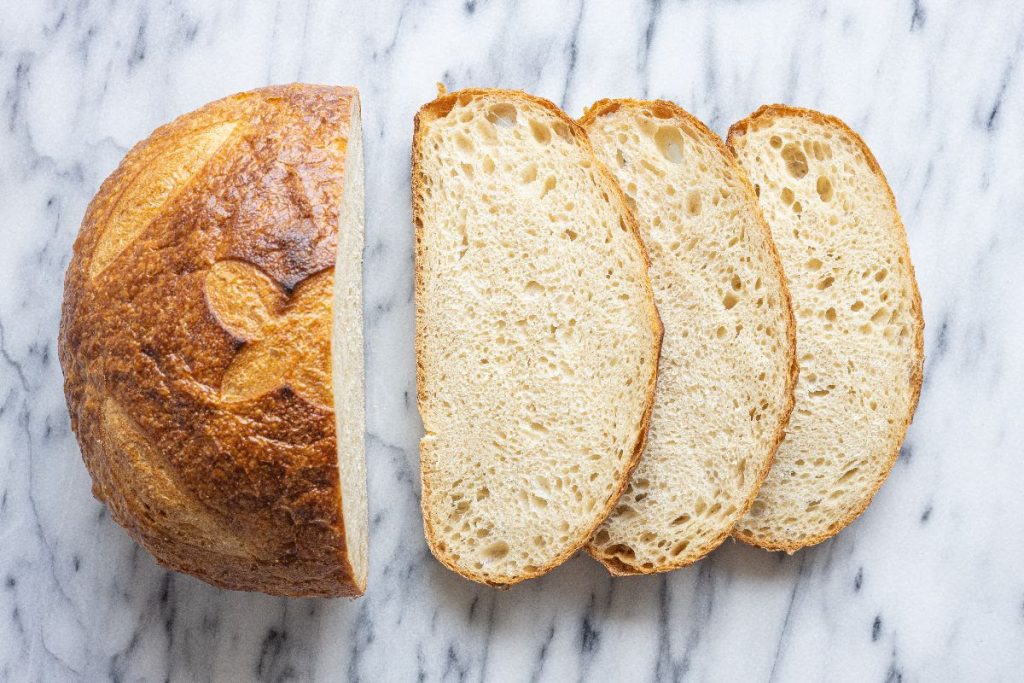
A Bakehouse bread that wins fans far and wide
By Ari Weinzweig
Lexie Smith, creator of the Bread on Earth project, says, “When the world around us stops making sense, I find comfort and clarity in bread.” I agree. Bread helps me stay centered. And as those who know me well already know, I am rarely without it.
It’s been nearly 30 years since we first started making this San Francisco-style sourdough bread, one of the original half-dozen offerings from the Bakehouse in 1992. Before we began baking this, back in the late ’80s, we were “baking off” par-cooked loaves of sourdough that we’d figured out how to ship in from a famous place in the Bay Area. At the time we started getting them, the par-baked breads were themselves a BIG improvement—previously, sourdough bread would not have appeared in a shop in this part of the world. Customers loved them, but over time, it became ever clearer that we could do better.
How we got started with our Sourdough
Starting in September of 1992, the Bakehouse sourdough was another giant step towards getting better. The bread we were baking here was way better in every sense of the word: texture, aroma, and flavor were all instantly improved. What we had previously thought pretty good turned out to be well below what was possible. We have never turned back on that improvement. The Better Than San Francisco Sourdough remains one of the Bakehouse’s best and most popular breads. It is also on the Roadhouse’s bread service, where you can enjoy it with the Vermont Creamery Cultured Butter, which we’re now also stocking at the Bakeshop. Last weekend, I watched a guest trying the sourdough with the cultured butter for the first time. She took one bite, paused to process the flavors, and then opened her eyes wide and mouthed the words, “Wow! Wow! Wow!”
Just to be clear up front, the “Better Than San Francisco” piece of the name comes not from some sort of competitive drive to be the “the best,” but because, baking here in Ann Arbor, half a world away from the Bay Area, we’re not allowed to use the name “San Francisco.” That said, it is not an exaggeration to say that we ship many loaves of this out to the Bay Area—and many customers have told me over the years that this is what they remember sourdough tasting like when they were kids growing up in northern California.
A slice of history about San Francisco Sourdough
In San Francisco, the bread and its popularity boomed during the Gold Rush Era. In January of 1848, gold was discovered in nearby Coloma and the “rush” quickly followed. At the time, California was still occupied territory, having been taken from Mexico by the American military. During the Gold Rush, the population and the economy in California boomed and California became a state in 1850, but the price was paid by Native peoples who were pushed off their land and decimated by disease. For better or for worse, San Francisco Sourdough is a legacy of that era.
The Bakehouse’s Better Than San Francisco Sourdough is true to these old Gold Rush era recipes. Natural sour starter—rather than the more modern commercial yeast—is used to develop both the flavor and texture of the finished loaf. It takes about 18 hours of rise time for the dough to develop its full flavor before being baked on the stone hearth. The key to this—or any good sourdough bread—is balance, noticeably sour, yet not at all over the top. It’s got a crackling, crisp crust, wonderful sour tang, and great, chewy texture. I’m with Amy Emberling, the Bakehouse’s Co-Managing Partner who says, “I really enjoy the thin, crisp crust—it’s very distinctive.” Coincidentally, I was speaking with a long-time customer a few years ago about growing up in San Francisco and eating sourdough there as a child. “Of course,” she said with a smile, “I like what you’re making at the Bakehouse a lot more than that. But back at the time it sure seemed good.”
Lexie Smith, writing in the New York Times last week, says,
Bread is a bellwether, its absence a death knell. In the corners of the world where bread flows freely and remains affordable for every rung of society, there is at least the potential for people to thrive.
Thanks to everyone at the Bakehouse, good bread indeed flows freely and frequently through the Zingerman’s ecosystem. It most certainly contributes significantly to my own sense of well-being, and I hope it does the same for you. A slice of this sourdough is a wonderful coming together of tradition and taste, of health and happiness, of well-being and being well-made. Make some toast, raise a toast, and enjoy.
